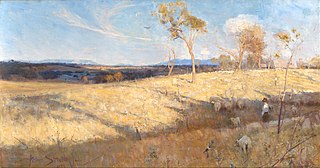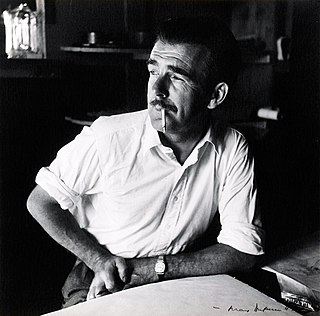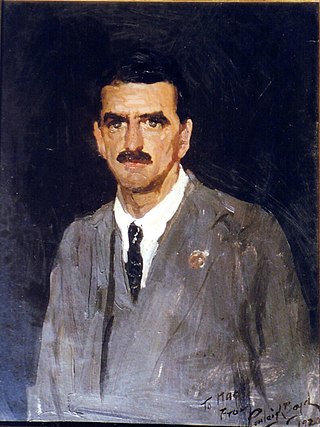
The Heidelberg School was an Australian art movement of the late 19th century. It has been described as Australian impressionism.

Charles Edward Conder was an English-born painter, lithographer and designer. He emigrated to Australia and was a key figure in the Heidelberg School, arguably the beginning of a distinctively Australian tradition in Western art.

Arthur Merric Bloomfield Boyd was a leading Australian painter of the middle to late 20th century. Boyd's work ranges from impressionist renderings of Australian landscape to starkly expressionist figuration, and many canvases feature both. Several famous works set Biblical stories against the Australian landscape, such as The Expulsion (1947–48), now at the Art Gallery of New South Wales. Having a strong social conscience, Boyd's work deals with humanitarian issues and universal themes of love, loss and shame.

Margaret Hannah Olley was an Australian painter. She held over ninety solo exhibitions during her lifetime.

Sir William Dobell was an Australian portrait and landscape artist of the 20th century. Dobell won the Archibald Prize, Australia's premier award for portrait artists on three occasions. The Dobell Prize is named in his honour.
James Timothy Gleeson was an Australian artist. He served on the board of the National Gallery of Australia.

Theodore Penleigh Boyd was an Australian artist.

Emanuel Phillips Fox was an Australian impressionist painter.

Ben Quilty is an Australian artist and social commentator, who has won a series of painting prizes: the 2014 Prudential Eye Award, 2011 Archibald Prize, and 2009 Doug Moran National Portrait Prize. He has been described as one of Australia's most famous living artists.

Leonard Phillips Fox was an Australian writer, journalist, social activist, and painter.
Tjunkiya Napaltjarri was a Pintupi-speaking Indigenous artist from Australia's Western Desert region. She is the sister of artist Wintjiya Napaltjarri.
Wintjiya Napaltjarri, also known as Wintjia Napaltjarri No. 1, was a Pintupi-speaking Indigenous artist from Australia's Western Desert region. She is the sister of artist Tjunkiya Napaltjarri; both were wives of Toba Tjakamarra, with whom Wintjiya had five children.

Ethel Carrick, later Ethel Carrick Fox was an English Impressionist and Post-Impressionist painter. Much of her career was spent in France and in Australia, where she was associated with the movement known as the Heidelberg School.
Catherine Hunter is an Australian filmmaker, journalist, television producer and director.

Florence Ada Fuller was a South African-born Australian artist. Originally from Port Elizabeth, Fuller migrated as a child to Melbourne with her family. There she trained with her uncle Robert Hawker Dowling and teacher Jane Sutherland and took classes at the National Gallery of Victoria Art School, becoming a professional artist in the late 1880s. In 1892 she left Australia, travelling first to South Africa, where she met and painted for Cecil Rhodes, and then on to Europe. She lived and studied there for the subsequent decade, except for a return to South Africa in 1899 to paint a portrait of Rhodes. Between 1895 and 1904 her works were exhibited at the Paris Salon and London's Royal Academy.

Edith Susan Gerard Anderson, who became Edith Susan Boyd when she married, was an Australian artist, dramatist, and painter. She was also known for being a model for the artist Emanuel Phillips Fox, notably in his 1912 painting Nasturtiums.
The Museum of Modern Art Australia (MOMAA), alternatively named the 'Museum of Modern Art of Australia,' or, according to McCulloch, the 'Museum of Modern Art and Design' (MOMAD), was founded by Australian art patron John Reed in 1958 in Tavistock Place, a lane-way off 376 Flinders Street, Melbourne, launched previously with a survey of Modernist Victorian women artists on 1 June 1956, organised by the Reeds who had taken on the then named Gallery of Contemporary Art. It held exhibitions of important contemporary Australian and international art of the late 1950s and early 1960s. The Museum operated until 1966 and was formally dissolved in 1981.

Arnold Joseph Victor Shore was an Australian painter, teacher and critic.
Rosemary Ryan was a mid to late twentieth-century Australian painter
Hermia Sappho Boyd (1931–2000) was an Australian artist, writer, and a member of the Boyd artistic dynasty.


















